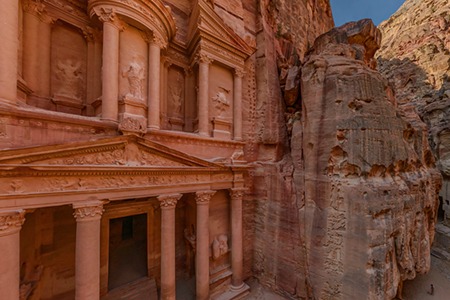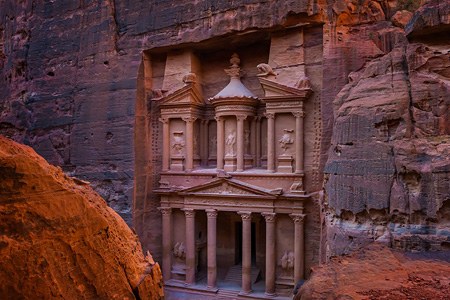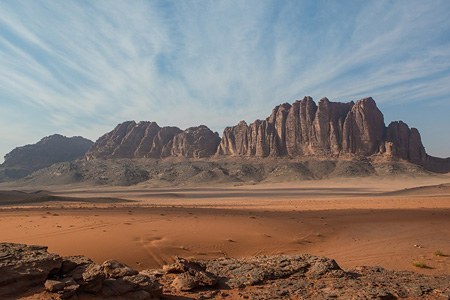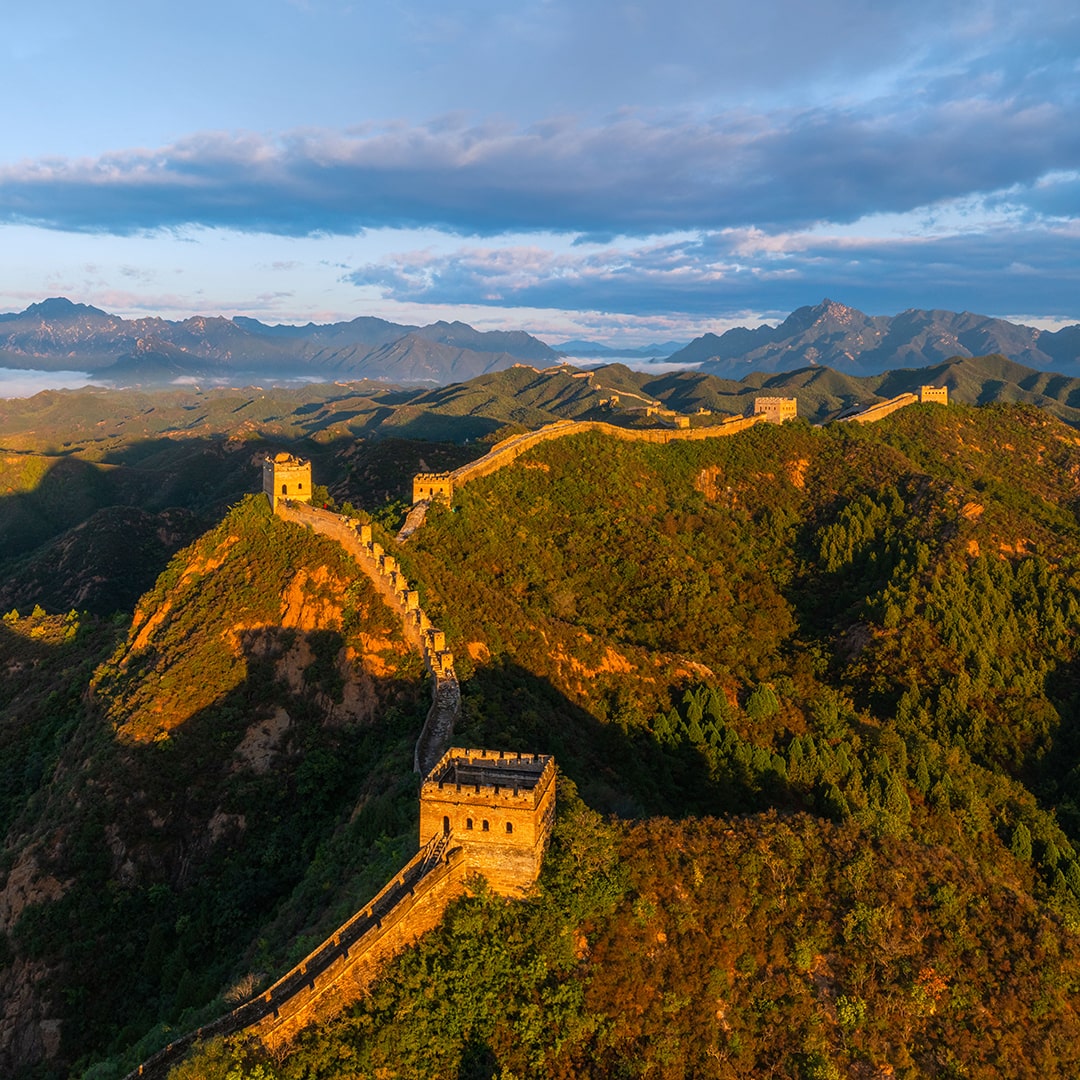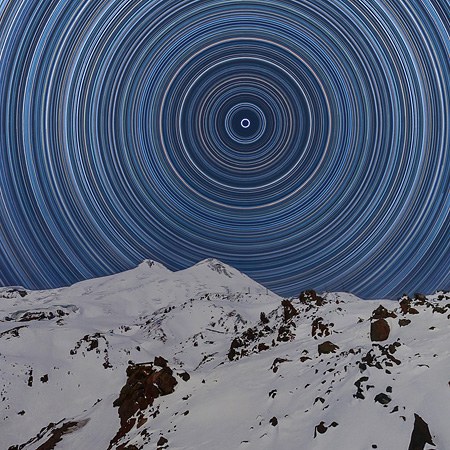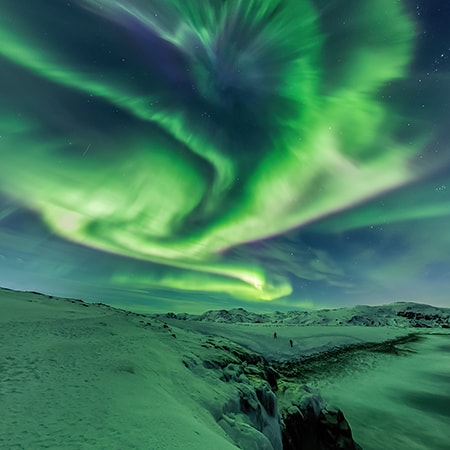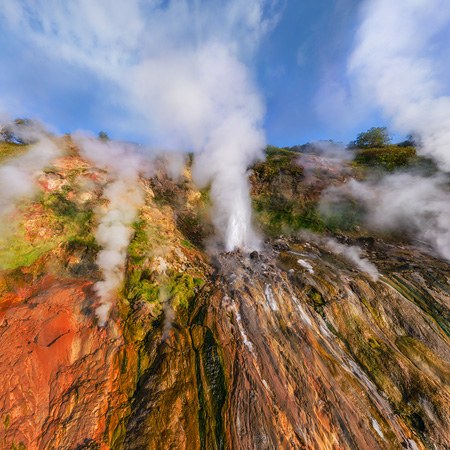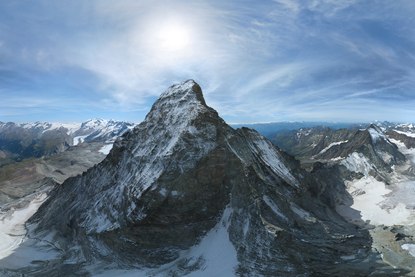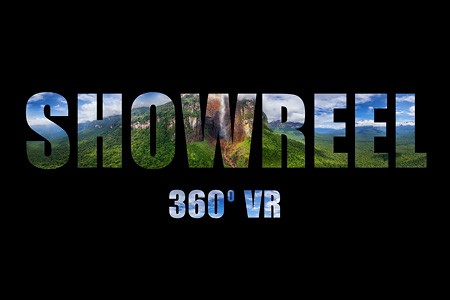Petra, Jordan
Petra - The Glory Of Decay
The Moon was lighting the road much better than streetlights lined up along the sidewalks. I walked in what appeared to be a complete silence. It was hard to imagine what would wait for me around a corner. Strange dome-like rocks watched me as I passed by their candle-lit caverns on my way to the City of the Dead. The trail became a narrow path between vertical red walls. The Moon couldn't reach here so I kept walking in silence in the dim light of streetlights that followed the long winding path. All I could hear were gusts of warm wind and rustling of lizards. Suddenly I saw a bright light ahead of me: in a few meters the walls opened to let me out into a candle-lit square. There was a man in a long white robe in the middle of the square. He raised his arms and I heard a flute. His music filled the entire space, flowing between the rocks, reflecting of yellow-red walls then disappearing in the endless night sky full of stars. An Arab stood in front of the Pharaoh Treasury, the grand building that overshadowed the entire ensemble. It could be easily mistaken for an ancient Greek temple if it would have had walls. But there were no walls. The façade, columns, porticos, statues, and steps leading into the dark inner rooms were carved directly in the rock with great precision... Light of hundreds of candles was illuminating the square. It seemed (or, perhaps, it was really so) I was a part of an ancient Pagan ritual...

Petra... this is how I entered Petra for the first time several years ago.
Petra is a city that lives in four dimensions. Or "lived" to be exact... My mind doesn't want to accept the fact that the majority of the breathtaking monumental rock castles are only random parts of a gigantic centuries-old multinational Necropolis. Historically (the Pyramids of Egypt, for example) Necropolis was built to stand for thousands of years. Temples and other religious structures were supposed to survive through centuries, and simple living quarters had a short life serving one or several generations at best.
No, Petra was not designed as Necropolis. Deep under the rocks, there once lived around twenty thousand people. There were markets, saunas, villas with swimming pools, a sophisticated water conduit system, theaters, government buildings, and the senate... it's just that the time, earthquakes, wind, and sand destroyed and hid away all mundane...

When thinking of Petra, I always want to add one more dimension that would take me into the depth of the mountain, as conventional geometry doesn't seem to be enough to describe carefully carved centuries-old rooms, caverns, storage spaces, altars, and obelisks.
Mysteries of The History
Similar to stone steps that lead to the High Place of Sacrifice, the giant altar on top of Zibb Attuf (the Bedouin name of the mountain ridge), the entire atmosphere here is filled with time that flows slowly like ancient blood of human sacrifices to the God of Sun.

Arabs that currently populate Jordan territory are rather skeptical about Old Testimony being an accurate historical document, and so they usually start their stories with "a hard-working Arab tribe of Nabataeans" settling down in Wadi Musa (commonly known as the Valley of Moses) in VI BCE. Later Greeks would change the name to "Petra" which means "a rock" or "a mountain".
The main source of Nabataean wealth were fees and duties collected from caravans for passing through their territory as well as for guarding and escorting them along the way. Among other sources of income were taxes collected from neighboring tribes and robbery activities. The Nabataean influence spread from Sinai to Damask. Rumors of the flourishing country attracted Rome's attention, but they couldn't concur Perta right away: mountains that surrounded Petra guarded the city very well, and it was relatively easy to protect the only city entrance (2 - 5 meters wide gorge called Siq) secured between vertical 80-meter high natural walls. However in 106 BCE Nabataeans lost to Emperor Trayan, and were absorbed by Roman Empire.
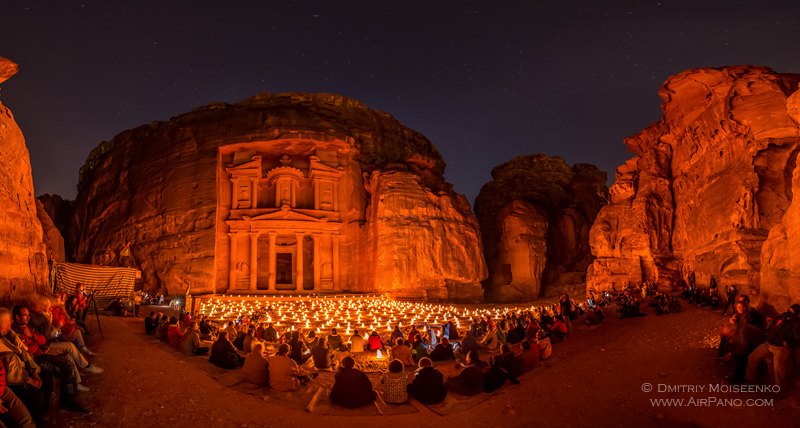
Petra has flourished for two more centuries under the rule of Rome, but has eventually lost its importance due to developing marine navigation on the Red Sea. When it happened Romans decided to leave the city. The Byzantines came to Petra during the time of neglect and repurposed some of the major structures to serve as Christian temples.
Arab invasion in the VIIth century didn't make much impact on Petra's culture and history. Petra was last mentioned in the XIth century during Kingdom of Jerusalem. Ruins of Crusaders' castle were found near the main sacrifice altar.
Since then Petra has practically disappeared from the face of the Earth. There were only legends told of countless Nabataean treasures buried deep in the Dead City somewhere in Jordan Mountains and bloodthirsty Bedouins who protected them...
In 1812 Swiss explorer Johann Ludwig Burckhardt introduced Petra to the Western World. In order to get there he had to learn Arabic language and study Koran. He looked like a Muslim; perhaps, this was the reason why Arabs agreed to show him the way to the Rock City. Finding a guide was a challenge - everybody was scared of evil spirits that lived in the Dead City according to Bedouins legends. Initially the guide was taking the explorer to the Tomb of Aaron for a sacrifice. However, as they walked through the narrow corridor and faced the 40-meter high Treasury carved in the rock, Burckhardt realized that they were in the legendary Perta. Admiring magnificent architecture he almost gave himself out in excitement, but his resourcefulness saved him from death from his guide's hand...
The Rock City. The Carved City...
Those who visited Petra would agree that one day is enough to fall in love with the city and to admire it; but even three days is not enough to walk all its paths, to see all its structures from The Treasury to The Monastery (Ad Deir) carved on the top of the mountain. Nabataeans left over 800 Nabataean carved monuments in Petra, not to mention other periods of its history.

Entrance to Petra goes though the Siq - a dark winding narrow gorge. There is a man-made kilometer-long channel carved in one of the walls, which served as a waterway from the Moses Spring to Petra. Ancient architects created a sophisticate system of dams, cisterns and water conduits to control the water level in the desert climate. There were fountains in city squares, and noble Nabataeans (and Romans after them) enjoyed sunbathing by private pools, ruins of which modern archeologists discovered in Petra... All this luxury was impossible to imagine by looking at lifeless rocks under the blazing Jordan sun.
Little carriages and tourists are rushing by, but I prefer to approach Al Khazneh, The Treasury, slowly. First, the façade of the most elaborate and beautiful building in Petra peaks through the mountain walls, and then - meter by meter - it opens in its full shining glory.

It's worth saying that names of the monuments don't necessarily convey their real purpose. As Nabataeans didn't leave a detailed map of the city, Arabs named locations based on myths, appearances, and guesses. For example, The Treasury is called after the legend about an ancient Pharaoh's bounty that was so large that slowed his army on its way East. They had to hide most of the treasures in the mountains... One can see countless bullet holes marking the surface of the Basin crowning the tower - the local Bedouins believed that this was the place of hidden riches and tried to crack the Basin open hoping for the golden rain...
Behind the columns, there are doors leading to inner quarters. It is believed that the small rooms served as a Tomb for Aretas IV Philopatris, the King of Nabataea. During his rein Petra reached its prime, advancing in architecture among other fields. The look of inner quarters of the Tomb is remarkable: color of sandstone flows from white to maroon as if brushed on by nature itself. The façade of the building (30-meter wide and 43-meter high) is carved in a solid rock and decorated with statues of Nabataean gods and goddesses. The Treasury overlooks the main square focusing on the Siq, the narrow entrance to the city. Nothing is in the view, but the rosy-red mountain walls, so it feels like Petra consists only of the Treasury. Nevertheless, right at the side of the building there is a walkway that suddenly opens up around the corner and becomes a wide road leading to the center of the ancient city. Façades of amazingly beautiful monuments are carved in stone run along both sides of the road.

It is believed that the "Street of Facades" was created during Assyrian period, and that architects of Petra incorporated a lot of Eastern design elements into their work. The road takes us to the huge Amphitheatre carved right in the mountain. It is impossible to count the exact number of seats; so different travel guides speak of three to seven thousand seats altogether. Initially Nabataeans built the Theater for their ritual purposes. Later on Romans enlarged it to accommodate almost half of the city during grand performances.
The purpose of rock structures is still unknown. Most former tombs were later used as quarters and temples. We don't even know if they were tombs in the first place! This is why in my description of Petra I will use common terms that are in use in modern Jordan.
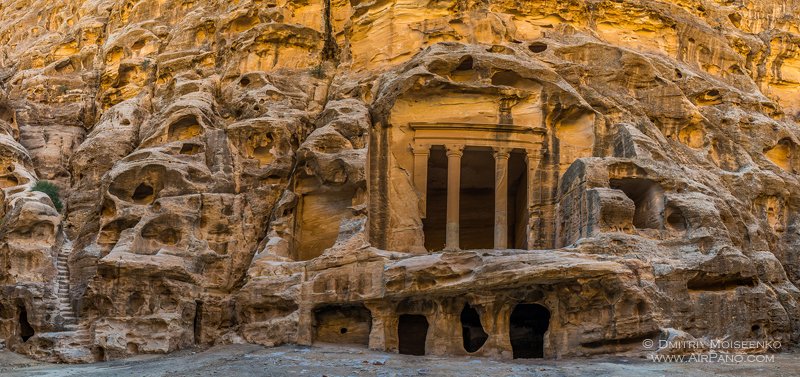
Several roads fan out from the Amphitheater, and each on them leads to its own period. If you turn right you will find yourself in the "Royal Tombs" complex. Go west, and you will see the ruins of Dushara Temple, dedicated to the main male god of Nabataeans. This is probably the only detached massive structure in the city.
The path then goes to the narrow gorge with steep 800-steps long stairs to Ad Deir, The Monastery - the largest structure in Petra.
We had to hire donkeys to go up the gorge. However, an experienced hardy traveler can make the path on foot.
Although the design of Ad Deir is less elaborate and doesn't have statues, comparing to the Treasury, it is much wider. We know for sure that during Byzantine period the building served as a Christian church, thus comes the name. One can climb the rocks to reach the urn on the very top. This is a great spot to admire the scale of Nabataean masonry and to enjoy the grand view of the valley of Moses. The only way out of this place is down...

From a distance, when observed from the Monastery, Royal Tombs look rather small comparing to Jabal Haroun ("Aaron's Mountain") where they are actually curved. The most remote tomb is dated 126 BC. This is the only tomb in Petra that has an actual name: it was built for Sextius Florentinus, the Roman governor of the Arabia province. When walking from this tomb toward the Amphitheater along the Wall of Kings, you will see the Palace Tomb, which façade resembles a Roman temple, the Corinthian Tomb that looks like the Treasury, but severely damaged by time and earthquakes, and also the Silk Tomb, which is relatively small comparing to others. Like a beautiful silk blanket, yellow, red, and grey sandstones cover its walls shining in the sun. The nearby Urn Tomb is as tall as the Treasury and the Monastery. Multi-level arched pedestal, interlacing stairwells, and a lateral colonnade lead to the top of the Urn Tomb, where one can find refuge from the blazing sun in the shade of a large room (17 by 19 meters) right behind the massive entrance...
And here is a bonus advice for those who read the entire article - when in Jordan, spend a day by the Dead Sea, enjoy a sunset in Wadi Rum desert, and relax for a couple of days by the Red Sea. But make sure to spend the rest of your time walking the streets of the Rock City!
_____________________
Our sincere thanks go to Ildar Yambikov, a wonderful photographer, who helped us to obtain permits and provided invaluable moral support during our photo expedition to Petra.
AirPano team is also thankful to:
— Mr Dorofeyev, Director of the Federal Agency ‘Rossotrudnichestvo’ Representative Office;
— Mr. Zaichikov, Acting Director of the Federal Agency ‘Rossotrudnichestvo’ Representative Office;
— Mr Soukhov, Head of the Information and Analysis Department of the Russian Center of Science and Culture
for providing necessary documentation, warm welcome, and accommodation.
Photo and text by Dmitry Moiseenko and Stanislav Sedov
7 January 2014
Read more
Photogallery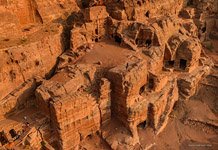 Petra, Jordan #2
Petra, Jordan #2
 Facades street #3
Facades street #3
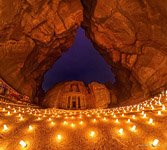 Petra at night #3
Petra at night #3
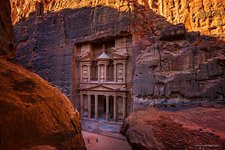 Al Khazneh #5
Al Khazneh #5
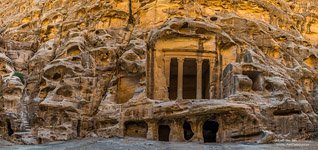 Petra, Jordan #1
Petra, Jordan #1
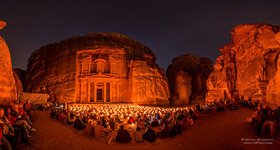 Petra at night #4
Petra at night #4
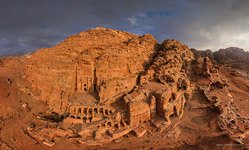 Urn Tomb
Urn Tomb
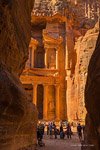 Al Khazneh #6
Al Khazneh #6
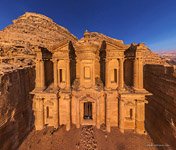 Ad Deir
Ad Deir
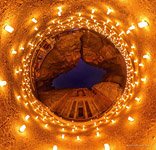 Petra at night #2
Petra at night #2
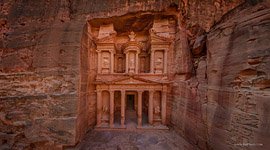 Al Khazneh #3
Al Khazneh #3
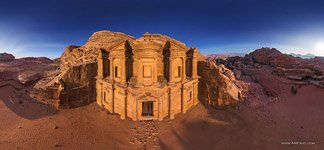 Ad Deir, or the Monastery
Ad Deir, or the Monastery




